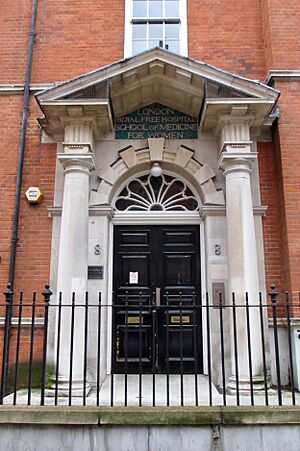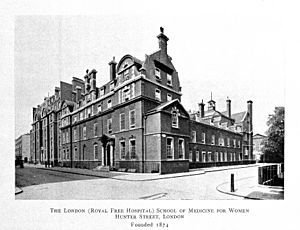London School of Medicine for Women facts for kids
The London School of Medicine for Women (LSMW) was a very important medical school in Britain. It started in 1874. It was the first school in the United Kingdom to train women to become doctors. People who supported the school wanted to give educated women a place to learn medicine. They also wanted to help women find jobs in healthcare, especially in caring for women and children.
In 1877, the Royal Free Hospital started letting women students from LSMW finish their medical training there. By 1896, the school's name changed to the London Royal Free Hospital School of Medicine for Women. It became part of the University of London. In 1947, the school began accepting both male and female students. Its name changed again to the Royal Free Hospital School of Medicine.
Later, in 1998, the school joined with the University College Hospital Medical School. They formed a new school called the Royal Free and University College Medical School. In 2008, this name was made shorter to UCL Medical School.
Contents
How the School Started
The London School of Medicine for Women was created in 1874. It was started by a group of brave women doctors. These included Sophia Jex-Blake, Elizabeth Garrett Anderson, Emily Blackwell, and Elizabeth Blackwell. Thomas Henry Huxley also helped.
One main reason for starting the school was because Sophia Jex-Blake had tried to get a medical degree in Edinburgh. But women were not allowed in British medical schools back then. She was even asked to leave Edinburgh University. Other women who had studied with her in Edinburgh joined her at the new London school. One of them was Isabel Thorne. She took over as the school's honorary secretary in 1877. Sophia Jex-Blake later moved to Edinburgh. There, she started the Edinburgh School of Medicine for Women in 1886.
A new law, the UK Medical Act of 1876, was very important. This law allowed medical groups to give licenses to all qualified people, no matter if they were men or women. This helped women become doctors legally.
In 1877, a special agreement was made with the Royal Free Hospital. This allowed students from the London School of Medicine for Women to do their practical training there. The Royal Free Hospital was the first teaching hospital in London to accept women for medical training.
Elizabeth Garrett Anderson became the Dean (leader) of the school from 1883 to 1903. During her time, the school was rebuilt. It became part of the University of London. Its connection with the Royal Free Hospital also became stronger. In 1896, the school was officially renamed the London (Royal Free Hospital) School of Medicine for Women.
Many women from India also came to study at the school. One famous Indian feminist, Rukhmabai, became a doctor there in 1894. By 1920, the school even opened a special place for Indian women medical students to live.
In 1914, the school grew even more. Many women wanted to study medicine. So, the school had to double its laboratories and classrooms. At that time, over 300 students were enrolled. This made it the largest university college for women in Britain.
In 1998, the school joined with the University College Hospital's medical school. They formed the UCL Medical School.
Important People Who Started the School
Elizabeth Blackwell
Elizabeth Blackwell was the first woman in the United States to earn a medical degree. She was born in Bristol, England, on February 3, 1821. Her family moved to America in 1832, settling in Cincinnati, Ohio.
After her father died, Elizabeth became a teacher to help her family. Her dream of becoming a doctor started when a dying friend told her she wished she had a female doctor. While teaching, Elizabeth learned a lot about medicine from two doctors who lived with her family.
In 1847, Elizabeth applied to many colleges. Most rejected her. Geneva College accepted her, but some people thought it was a joke. Despite facing unfair treatment, Elizabeth worked hard. She graduated at the top of her class. She slowly earned the respect of her teachers.
Elizabeth then returned to New York City. She opened a small clinic with the help of her friends. During the Civil War, she provided jobs for women doctors. She also trained women nurses for the Union hospitals.
In 1869, she moved back to England. From 1875 to 1877, she taught about women's health at the new London School of Medicine for Women.
Sophia Jex-Blake
Sophia Jex-Blake was born in Hastings, UK, in 1840. She went to Queen's College. Sophia wanted to study medicine at the University of Edinburgh. However, the university did not allow women to attend.
To fight this, Sophia took the university to court. She lost the case. But her struggles helped lead to a new law in 1889. This law allowed women to get medical degrees. Because of her efforts, Sophia Jex-Blake became one of the first female doctors in the UK. She then helped start both the London School of Medicine for Women and the Edinburgh School of Medicine for Women.
Elizabeth Garrett Anderson
Elizabeth Garrett Anderson was born in Whitechapel, London. She received a good education. She decided to become a doctor after meeting Doctor Elizabeth Blackwell. Elizabeth Garrett Anderson applied to several medical schools, but they all rejected her.
So, Elizabeth became a nurse at Middlesex Hospital. In 1866, she got a job as a medical helper at St. Mary's Dispensary. Still wanting to be a doctor, she successfully earned a medical degree in France.
When she returned to London, Elizabeth helped create the New Hospital for Women. This was at St. Mary's Dispensary. She also helped found the London School of Medicine for Women. Elizabeth later became the Dean of the London School in 1883. She oversaw its growth. She also appointed Elizabeth Blackwell as a professor. The school was later renamed the Elizabeth Garrett Anderson Hospital. It eventually became part of the University of London.
Notable Alumni
Many important women doctors studied at the London School of Medicine for Women. These include:
- Dame Louisa Aldrich-Blake, the first woman in Britain to earn a Master of Surgery degree.
- Diana Beck, a brain surgeon at Middlesex Hospital.
- Rosemary Biggs, a blood specialist.
- Margery Blackie, who was a homeopath to Queen Elizabeth II.
- Dame Hilda Bynoe, who became the Governor of Grenada.
- Janet Elizabeth Lane-Claypon, who helped start the science of how diseases spread.
- Eleanor Davies-Colley, a surgeon and co-founder of the South London Hospital for Women and Children.
- Louisa Garrett Anderson, a co-founder and chief surgeon of the Women's Hospital Corps.
- Helen Mackay, the first female member of the Royal College of Physicians.
- Flora Murray, a co-founder of the Women's Hospital Corps.
- Christine Murrell, the first female member of the British Medical Association Central Council.
- Alice Stewart, an epidemiologist who changed how we understand radiation risk.
- Lucy Wills, who discovered a nutritional factor (folate) that helped prevent a type of anemia in pregnancy.
- Jane Elizabeth Waterston, known as the first woman doctor in South Africa.
Joining Other Schools
From 1947, the school started accepting men. It was renamed the Royal Free Hospital School of Medicine. It faced possible closure a few times. But it kept operating on its own until 1998. That year, it joined with the University College Hospital Medical School. They created the Royal Free and University College Medical School. This school is now known as the UCL Medical School.
The original building of the London School of Medicine for Women later housed the British College of Acupuncture. In 2008, it also became the Hunter Street Health Centre.
See also
- New Hospital for Women, also started by Elizabeth Garrett Anderson
- Edinburgh School of Medicine for Women
- Women in medicine
- Henrietta Stanley, Baroness Stanley of Alderley, a supporter of the London School of Medicine for Women.



